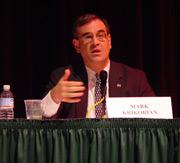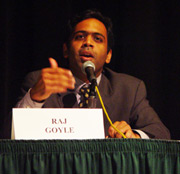Immigration debate explores positions and solutions
 Immigration is woven deep into the history of the United
States, a nation that was founded by immigrants and always has had a
rather liberal policy regarding legal immigration. Today, however, the
country is facing increasing challenges concerning illegal as well as
legal immigration.
Immigration is woven deep into the history of the United
States, a nation that was founded by immigrants and always has had a
rather liberal policy regarding legal immigration. Today, however, the
country is facing increasing challenges concerning illegal as well as
legal immigration.
At a debate sponsored by the Thomas Jefferson Program in Public Policy, immigration analysts Mark Krikorian from the Center for Immigration Studies (CIS) and Rajeev Goyle from the Center for American Progress hashed out these issues in a forum moderated by Washington Post columnist Stephen Barr.
Illegal immigration is not a minor issue insofar as today more than 11 million illegal immigrants are residing in the United States. Policy makers must decide not only how to handle illegal immigrants who are still trying to get into the country but also how to handle those who are here. While there is a consensus about the problem, there is little agreement about the solution.
Agreement on enforcing border security
Krikorian noted that in discussing immigration it is helpful to recognize the difference between immigration policy, which involves decisions about how many people the United States should accept on an annual basis, and immigrant policy, which involves how the nation deals with those who already are in the country.
The policy in place today, Krikorian explained, is a high-immigration and anti-immigrant policy that says it is all right to let in lots of people but not to let them get too comfortable. CIS, he added, supports pro-immigrant (legal) policies with less immigration. Stopping illegal immigrants would create a natural attrition.
 Goyle also noted the value in enforcing border security to stem the
tide of illegal immigration but sees better solutions in terms of
creating greater legal avenues for immigrants to come into the country.
The influx of immigrants is not wholly a bad problem for the United
States, said Goyle, adding “by and large we have an undocumented
population that is growing, that is large but that is producing and
contributing to this economy.”
Goyle also noted the value in enforcing border security to stem the
tide of illegal immigration but sees better solutions in terms of
creating greater legal avenues for immigrants to come into the country.
The influx of immigrants is not wholly a bad problem for the United
States, said Goyle, adding “by and large we have an undocumented
population that is growing, that is large but that is producing and
contributing to this economy.”
One solution, the wholesale deportation of illegal immigrants, is
too costly, Goyle said. A recent study by the Center for American
Progress found that to locate and deport all of the illegal immigrants
in this country would cost $206 billion over five and a half years.
Another
answer, the guest-worker program proposed by the Bush administration
and a potential legal avenue for immigrants, is no solution in
Krikorian’s eyes. He equated it to previously tried amnesty programs.
“Amnesty is [nothing more than saying] the illegals get to stay.
Enforcement has to come first.”
Goyle noted the guest-worker program could be beneficial because not only are the immigrants contributing to the economy but also because the United States does not have the work force to provide the labor that is needed. “We’re not birthing enough babies in this country to keep up with the replacement rate and to keep up with the growth of our economy,” he said.
A need for comprehensive reform
Constitutional rights also come into play in the deportation discussion. Krikorian said the courts have gone too far. “[Illegal immigrants deserve] the human rights God gave them, not the constitutional rights the Supreme Court has given them.”
Goyle said that although he believes immigrants deserve constitutional protection, he did not see the Supreme Court really offering the kind of protection Krikorian implied. He noted that illegal immigrants have vastly restricted rights in the courts. “[A] two-tired system is the reality,” he said.
“We’d get more bang for the buck [by] putting future moneys in interior control,” responded Krikorian to a question on border control. “You can’t just control within,” retorted Goyle, “you have to control demand.”
The debaters agreed that comprehensive reform of immigration policy is the only answer; however, the debate about just which reforms would be most equitable and effective and which form it should take continues.
 Skip to main content
Skip to main content
